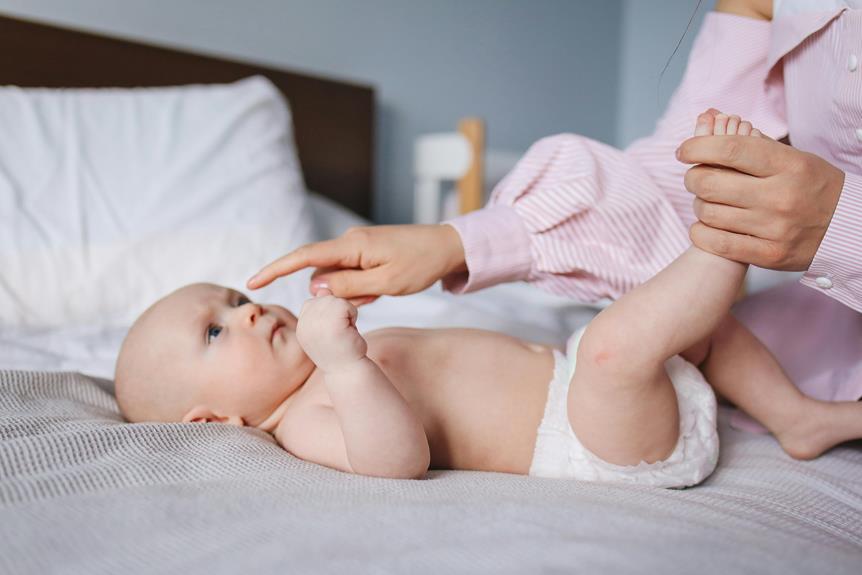3 Essential Tips for Changing Newborn Diapers
When establishing your newborn’s diaper changing station, first prepare your area: make certain everything you need, like diapers, wipes, and a diaper pail, is within reach. Next, master the fit of the diaper. Choose the right size for your baby’s weight and adjust it snugly to prevent leaks, ensuring you can fit two fingers under the waistband. Finally, handle diaper disposal efficiently. Use a foot-pedal diaper pail to keep the process hands-free and contain odors with a sprinkle of baking soda. By following these steps, you’ll keep your baby comfortable and clean. There’s more to explore that can further simplify your routine.
Key Takeaways
- Select the correct diaper size based on your newborn’s weight and age.
- Ensure the diaper fits snugly around the waist and legs to prevent leaks.
- Check and change diapers promptly using the wetness indicators.
- Keep all necessary supplies within reach at a secure and stable changing station.
- Maintain hygiene by cleaning the baby’s skin before and after each diaper change.
Prepare Your Changing Station
Before you start changing your newborn’s diaper, make sure your changing station is fully equipped and easily accessible. Safety precautions are paramount, so first and foremost, guarantee the changing area is stable and secure. A rolling cart or a dedicated changing table with raised edges can prevent your baby from rolling off. It’s also critical to have all necessary items within arm’s reach to avoid leaving your baby unattended.
Your station essentials should include a stock of clean diapers, baby wipes, a trash bin for disposal, and a waterproof changing pad. Additionally, keep hand sanitizer nearby to maintain cleanliness before and after the diaper change. For emergencies, have a kit with extra clothing for your baby, diaper rash cream, and a soft towel or blanket for additional comfort.
Master the Diaper Fit
Securing a proper diaper fit is essential to keep your newborn comfortable and prevent leaks. Start by selecting the right diaper size based on your baby’s weight and age. Too tight and it could cause discomfort and skin irritation; too loose, and you risk leaks and blowouts.
Check the diaper’s wetness indicators to gauge when it’s time for a change. These lines change color when the diaper is wet, making it easy to know without disturbing your baby too much. Adjust the diaper snugly around your baby’s waist. The top of the diaper should sit just below the belly button, and the leg cuffs should encircle the legs without any gaps.
You’ll find adjustable tabs on either side of the diaper. These should be fastened symmetrically on both sides for an even fit. Make sure they’re secure but not digging into your baby’s skin. A good rule of thumb is to make sure you can fit two fingers under the waistband of the diaper.
Lastly, after fastening, run your fingers around the edges to tuck in any stray points that might cause leaks. With these steps, you’ll master the diaper fit, keeping your newborn dry and happy.
Handle Diaper Disposal Efficiently
After changing your newborn’s diaper, promptly disposing of it prevents odors and maintains hygiene. You’ll want to employ effective odor control and sanitation techniques to make sure your home stays fresh and clean. Here’s how to handle diaper disposal efficiently:
First, consider using a dedicated diaper pail designed specifically for diaper disposal. These pails are equipped with seals and traps that help contain odors. It’s important to choose a model with a foot pedal, allowing you to operate it hands-free, which is essential for maintaining sanitation.
Second, always make sure to wrap the used diaper tightly before disposal. This minimizes the exposure of the contents and significantly reduces the smell. You can use the diaper’s own adhesive strips to seal it up neatly. For added odor control, sprinkle some baking soda into the diaper pail or directly into the diaper before sealing it.
Lastly, regular maintenance of your disposal system is key. Replace the liner of your diaper pail frequently—don’t wait until it’s overflowing. Clean the pail with disinfectant every few days to prevent bacteria buildup and keep the area around the diaper disposal station sanitized.
Frequently Asked Questions
How Often Should a Newborn’s Diaper Be Changed?
You should change a newborn’s diaper every two to three hours, and definitely during nighttime feedings to prevent discomfort and rash. Sticking to this diaper schedule guarantees your baby stays clean and comfortable.
Can Diaper Cream Cause Diaper Rash?
Yes, diaper cream can cause diaper rash if your baby’s sensitive to certain cream ingredients. Allergic reactions can occur, so it’s important to monitor your baby’s skin response when using new products.
What Signs Indicate a Diaper Is Too Tight?
If you notice red marks on your baby’s skin or observe any breathing discomfort, these signs indicate the diaper is too tight. Selecting a comfortably fitting diaper for your baby is crucial.
Are Cloth Diapers Better for Newborns?
Cloth diapers are often better for newborns due to their lower environmental impact and reduced long-term cost. You’ll find them gentle on the skin and less wasteful, making them a sustainable choice.
How to Deal With Diaper Leaks at Night?
To manage nighttime diaper leaks, you’ll need to perform absorbency tests on different brands. Incorporate findings into your bedtime routine, selecting the most absorbent option to guarantee your baby stays dry all night.
Conclusion
Now you’re ready to tackle newborn diaper changes like a pro!
Remember to keep your changing station well-stocked and organized.
Make sure diapers fit snugly but comfortably around your baby’s waist and legs to prevent leaks.
Efficiently dispose of diapers to maintain hygiene and reduce odors.
With these tips, you’ll guarantee your baby stays clean and comfortable while keeping the process smooth and stress-free for both of you.
Happy changing!

Chad Adan Kace, a young dad from Vermont, shares his parenting journey with a touch of humor and lots of love. Father to a lively baby, he explores the joys and challenges of fatherhood through his stories.







